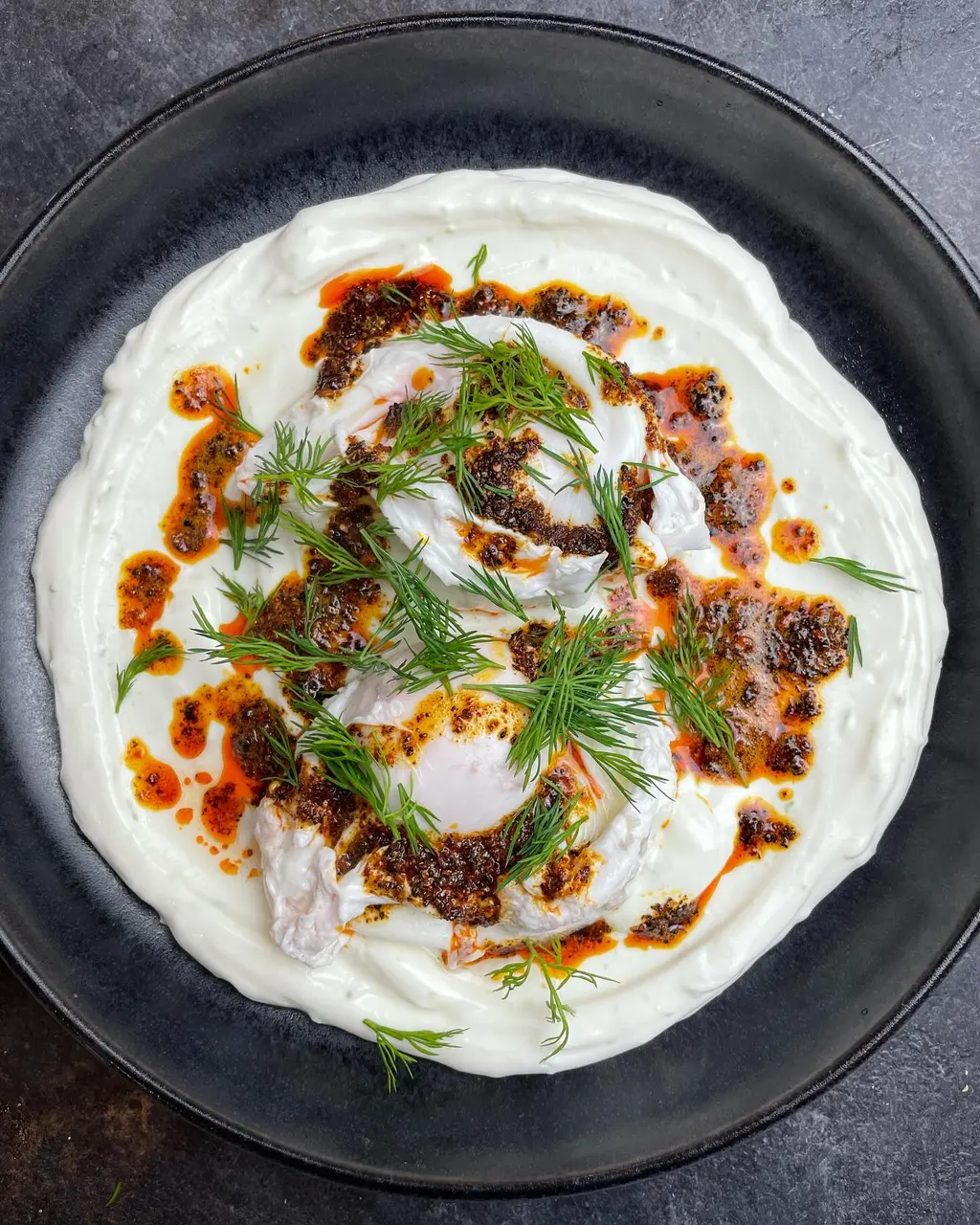Many egg dishes promise richness, but few deliver the balance of flavor and texture found in Turkish poached eggs.
This recipe brings together silky poached eggs, tangy garlic yogurt, and a spiced butter drizzle that transforms a simple breakfast into something memorable.
The combination of creamy, spicy, and herby layers makes every bite both satisfying and elegant.
The Allure of Turkish Eggs
Known in Turkey as Çılbır, this traditional dish is a comfort classic that dates back centuries. What makes it remarkable is its simplicity: poached eggs nestled on a base of creamy yogurt and finished with a drizzle of chili-infused butter.
The ingredients may seem minimal, yet the result feels luxurious. The tang from the yogurt cuts through the richness of the butter, while the subtle heat from the chili awakens the palate.
It’s a perfect blend of soothing and stimulating — a dish that feels indulgent but remains wholesome.
Choosing the Right Yogurt
The foundation of this recipe lies in thick, full-fat Greek yogurt. Its dense, velvety texture provides the ideal base for the poached eggs to rest upon.
Always choose yogurt with live cultures and minimal additives. Low-fat versions tend to release water when mixed with garlic and citrus, making the dish loose rather than creamy.
If your yogurt isn’t thick enough, strain it through a cheesecloth for 20–30 minutes to remove excess whey.
Adding a small amount of grated garlic gives a savory backbone to the yogurt, while lime zest offers a gentle brightness that prevents the flavor from feeling heavy. Salt brings everything together, deepening the tang and enhancing the creamy texture.
Perfectly Poaching the Eggs

The heart of this dish is the poached egg. Achieving the perfect poach means balancing tenderness with structure. The whites should hold shape without becoming rubbery, and the yolk must remain luxuriously soft.
To achieve this, bring a saucepan of water to a gentle simmer — not a full boil. Stir in a splash of vinegar to help the whites set neatly around the yolk. Crack each egg into a small bowl, then carefully slide it into the water. Poach for about four minutes for a runny center.
Once done, remove the eggs with a slotted spoon and place them on a paper towel to remove excess moisture. This small step prevents water from diluting the yogurt base later.
Crafting the Chili Butter
While the eggs rest, prepare the finishing touch: a nutty chili butter that brings heat and aroma. Melt butter in a small pan over medium heat until it begins to foam and turn golden brown. This browning process adds a slightly caramelized flavor that pairs beautifully with the tangy yogurt.
At this stage, stir in Aleppo pepper flakes. They offer a mild, fruity heat rather than the sharp burn of crushed red pepper. If Aleppo pepper isn’t available, a mix of smoked paprika and a touch of cayenne provides a similar warmth and color.
Let the butter bubble briefly until fragrant. It should have a deep amber hue and a toasty aroma — this is when it’s ready to drizzle over the eggs.
Assembling the Perfect Plate

Presentation matters as much as flavor in this dish. Begin by spreading the garlicky yogurt mixture onto the base of a shallow bowl or plate. Create a slight well in the center where the eggs will rest.
Carefully place the poached eggs on top, then spoon the warm chili butter over them. The butter will cascade down into the yogurt, streaking it with red-gold trails of flavor. Finish with a scattering of fresh dill for a touch of brightness and aroma.
Serve immediately with slices of warm crusty bread or soft pitta, perfect for dipping and scooping every layer together. The contrast between the cool yogurt, warm eggs, and spicy butter is what makes this dish unforgettable.
Why This Dish Works
What sets Turkish eggs apart is the way each element supports the others. The yogurt cools the heat from the butter, while the eggs add richness that ties it all together. The herbs and citrus prevent heaviness, keeping the dish lively and balanced.
It’s a rare combination of comfort and sophistication. Whether you enjoy it for breakfast, brunch, or even dinner, it feels special yet approachable. Pair it with a side of greens or a light salad to round out the meal.
If you enjoy dishes with balanced textures and bold flavors, you might also like the Creamy Sundried Tomato Chickpeas or the Persian Chicken with Chickpeas — both celebrate the same Mediterranean depth and warmth.
Customizing Your Turkish Eggs

While traditional Çılbır relies on minimal ingredients, there’s room for creativity. For those who prefer extra heat, a drizzle of chili oil can amplify the spice level.
Adding herbs like mint or parsley can brighten the flavor further, while a sprinkle of sumac lends a subtle tartness. A handful of sautéed spinach underneath the yogurt turns it into a heartier brunch bowl.
For a more filling variation, serve alongside roasted sweet potatoes or warm grains like quinoa. Similar to the Crispy Sweet Potato Kale Quinoa Fritters, these additions create a wholesome, balanced meal that’s both nutritious and satisfying.
Serving Suggestions and Pairings
Turkish eggs pair beautifully with fresh bread — especially homemade pita or sourdough. The bread acts as both utensil and companion, soaking up the yogurt and butter perfectly.
A simple side salad of cucumber, tomato, and red onion provides a cool contrast. The freshness of the vegetables complements the richness of the dish. A cup of mint tea or lightly brewed coffee rounds out the experience.
If you’re hosting brunch, consider offering a few other dishes alongside. Options like Blueberry Cream Cheese Blintzes add sweetness, while savory bites such as Cheesy Sausage Hashbrown Bites can turn the meal into a spread.
Common Mistakes to Avoid

The simplicity of Turkish eggs leaves little room for error, but each step matters. Using thin yogurt can cause the sauce to pool rather than coat the eggs. Always opt for thick, full-bodied yogurt or strain it beforehand.
Overcooking the eggs can make the yolk firm, losing the signature creaminess. Keep the water at a gentle simmer, and don’t leave the eggs unattended.
Finally, the butter should be watched closely. Once it starts browning, it can burn quickly. A light amber color is ideal — rich in flavor without bitterness.
Storing and Reheating
Turkish eggs are best served immediately, but you can prepare parts ahead. The yogurt mixture can be made and refrigerated up to a day in advance. Allow it to come to room temperature before serving so it doesn’t chill the eggs.
Poached eggs can be cooked slightly underdone, then submerged in cold water and refrigerated for a few hours. To reheat, place them briefly in warm water for 30 seconds before serving. The chili butter can also be prepared early and gently reheated just before plating.
Nutrition and Benefits
This dish offers an excellent balance of protein, healthy fats, and probiotics. Eggs provide essential amino acids, while Greek yogurt contributes calcium and gut-friendly bacteria. The butter, used moderately, adds richness without overwhelming the dish.
The herbs and lime zest add antioxidants and vitamin C, bringing both freshness and healthful benefits. Altogether, it’s a meal that feels indulgent yet nourishes the body.
Frequently Asked Questions
Can I use regular yogurt instead of Greek yogurt?
Yes, but it should be strained to achieve a thicker consistency. Thin yogurt may water down the dish and alter its creamy texture.
What can I use instead of Aleppo pepper?
A combination of smoked paprika and a small pinch of cayenne works well. It recreates the color and gentle warmth without overpowering the other flavors.
Do I need vinegar for poaching eggs?
A small splash of vinegar helps the egg whites set neatly, but it’s optional. You can skip it if you prefer a more neutral taste.
Can this dish be made dairy-free?
Yes. Substitute the yogurt with a thick plant-based alternative, such as coconut or almond yogurt, and use dairy-free butter. Keep in mind this will slightly change the flavor profile.
What’s the best bread to serve with Turkish eggs?
Soft pita, sourdough, or crusty baguette slices work best. Each provides a satisfying contrast to the creamy textures and soaks up the flavorful butter beautifully.
Can I prepare this for multiple people?
Absolutely. Simply multiply the ingredients and poach several eggs at once in a large pot. Work in batches to maintain control over doneness.
Final Thoughts
Creamy Turkish Poached Eggs with Chili Butter and Garlic Yogurt embody the essence of balanced simplicity. The combination of smooth yogurt, runny yolk, and spiced butter creates a dish greater than the sum of its parts.
It’s perfect for weekend brunches, cozy solo breakfasts, or as a showstopping starter for guests. With just a few ingredients and careful timing, you can recreate this timeless Middle Eastern-inspired comfort food right in your own kitchen — rich, bright, and beautifully balanced.
Suggested next reads:

Creamy Turkish Poached Eggs with Chili Butter and Garlic Yogurt
Ingredients
Method
- In a bowl, combine the Greek yogurt, grated garlic, lime zest, and a small pinch of salt. Mix until smooth and creamy. Set aside to allow the flavors to meld.
- Bring a saucepan of water to a gentle simmer. Crack the eggs one by one into small bowls, then carefully slide them into the simmering water. Poach for about 4 minutes for soft, runny yolks.
- Remove the poached eggs with a slotted spoon and drain on a paper towel to remove excess water.
- In a small pan, melt the butter over low heat until it turns golden brown and releases a nutty aroma. Stir in the Aleppo pepper flakes and let it sizzle until frothy, then remove from heat.
- To assemble, spread the yogurt mixture onto a serving plate or shallow bowl. Place the poached eggs on top, drizzle the hot chili butter over them, and scatter with fresh dill.
- Serve immediately with warm pitta or crusty bread for dipping.
Notes
- Use thick Greek yogurt for the best texture; strain if needed.
- Poach eggs gently for perfectly runny yolks.


Leave a Reply